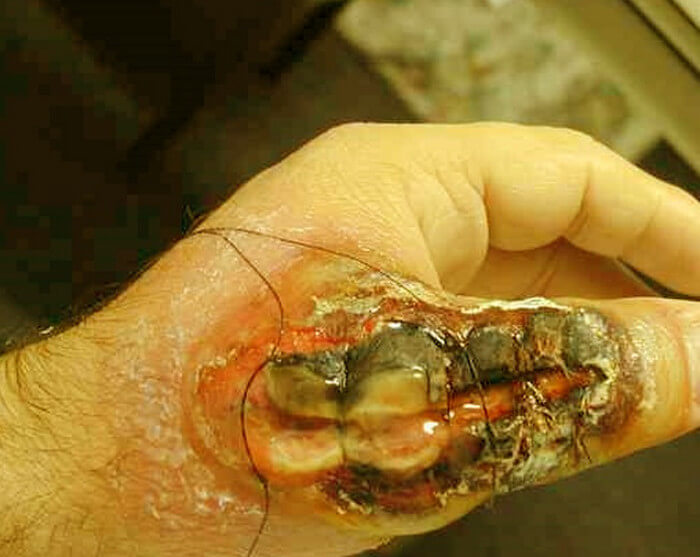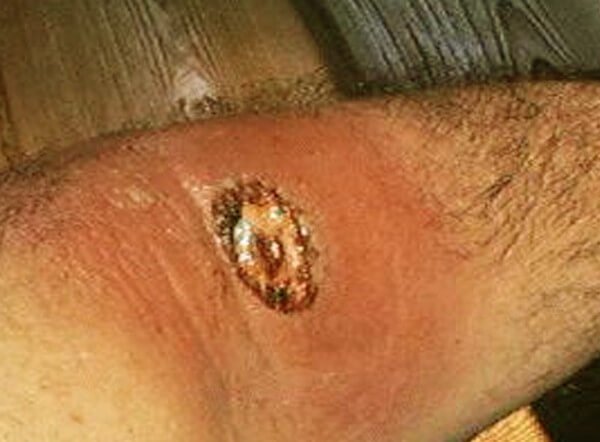Brown Recluse Spider Bite
What is a Brown Recluse Spider Bite
The brown recluse spider is also known as violin spider or fiddle back spider.
It habitats in the south central part of the US and prefer hot, abandoned and dry place such as rock pile or wood. While most of the spices of spiders are harmless to humans, the brown recluse spider is poisonous and its bite may cause severe symptoms including tissue damage.
Symptoms of Brown Recluse Spider Bite
The signs and symptoms depend on the amount of venom injected and the body’s response to the venom. Initially, there are no signs and symptoms of spider bite. They occur after 2-8 hours of the incident. The symptoms start with mild burning sensation at the site followed by irritation. The victim may have one or more of the following symptoms
- Severe inflammation
- Intense pain
- Bluish blister
- Redness on and around the wound
- Chills and rigor
- Nausea or vomiting
- Seizures (in severe condition)
- Joint pain
- Body ache
- Lesion that appears like pimple
- Lesion might be filled with green or yellow pus
- Formation of ulcer (after skin tissues are severely damaged)
- Rashes
- Necrosis (the death of the cells)
- Itching
- Dark urine
- Fever
- Muscle cramps/pain
The bite of the brown recluse spider causes a painful wound that does not heal quickly. Though fatalities are quite rare in this case, in young children and elderly with poor immunity, bites could be dangerous and may produce volcano lesion. Volcano lesion is damaged gangrenous tissues that appear like a hole in the flesh.
Stages of Brown Recluse Spider Bite
In some severe cases, the bite undergoes several stages of damaging tissues and become fatal. The stages include…
- Destruction of RBCs (red blood cells)
- Reducing the count of platelets
- Clotting of blood in vessels but not occurring where needed
- Damage of kidneys
- Stage of coma
- Death
Pathophysiology – How the Symptoms progress
The venom of the spider is lethal to the tissues and cells in the body. The venom is composed of enzymes that are fatal to the human body. Of many, certain enzymes cause destruction of local cells’ membrane. This further disrupts fat, skin and blood capillaries resulting in death of the cell (the condition is referred to as narcosis).
As response to the venom, the immune system relieves inflammatory mediators like histamine, cytokine and interleukin. The response further triggers the white blood cells to come to the site and handle the invasion.
How to Prevent the Brown Recluse Spider Bite
Prevention is better than cure. If you live in spider prone areas, clean closets, woods and shades. Shake out the shoes before wearing. Check your bedspread every time you go to the bed. Regularly check woodpiles and other waste from outside area. You must wear gloves, shoes, full sleeved shirts and pants while workout backyard or in veranda. Normally, spiders are not aggressive unless you touch them. You may make some noise before entering into such areas where spiders are likely to live. Noise keep them away and you avoid brown recluse spiders’ bite. These spiders are more active during the months of April to October. They mostly roam during nights and they prefer living in dry, dark and warm spots such as woodpile, board, rock, and wooden rack etc.
What to do in case of brown recluse spider bite?
Firstly, you must be sure that it was brown recluse spider that bit you. If you live in region where these spiders are seen (south-central part of the United States), you must have knowledge to identify it. If you think that the bite is of brown recluse spider, you must remember tips mentioned below-
- Remain calm. If you become too much anxious and panic, there are more chances to have the poison spread speedily. Over excitement is likely to fasten the flow of venom across the body.
- On the site, apply ice packs. If ice is not available, apply wet cloth and cover the bitten site. This helps preventing dust and microorganisms to enter the wound.
- Never apply a tourniquet. It harms than benefit in brown recluse spider bite.
Treatment For Brown Recluse Spider Bite
As it is very difficult to diagnose the brown recluse spider bite only based on wound’s appearance, victim’s history is the major factor to identify it. In fact, the history of bite plays a crucial role in treating it. The treatment of brown recluse spider bite depends on the amount of venom injected, time of the bite, present health problem, current medication and the allergies, if any. After diagnosing it, doctor may prescribe some lab tests such as complete blood count, electrolytes, functioning of kidneys, blood clotting factors, and urine analysis etc.
Four common ways to treat the bite
- Tetanus injection to prevent tetanus
- Pain killers to alleviate the severity of pain
- Antibiotics (especially to treat or avoid infection through the wound)
- Antihistamine to reduce swelling and itching
There is no antivenin available for this in the US. Nevertheless, steroids are used in very severe cases if the bite has caused fatal conditions such as anemia, delayed blood clotting and renal failure.
In cases with complications, compromised immunity and large amount of venom injection, hospitalization may be required. Also, if the case has become complicated and necrosis has spread, the removal of dead cell (or the organ itself) is advised.
Pictures of Brown Recluse Spider Bite

Picture 1 : Brown Recluse Spider Bite on thumb

Picture 2 : Brown Recluse Spider Bite – center areas shows pus and tissue inflammation

Picture 3 : Brown Recluse Spider Bite on back of leg – center areas shows signs of necrosis (tissue death)
Image source : www.ascendedhealth.com
References:
- Drugs.com
- Wikipedia
- Ohioline.osu.edu
- eMedicineHealth
- WebMD
- About.co
- Discovery.com
- MedicineNet.com
Published by Dr. Raj MD under Diseases and Conditions.
Article was last reviewed on August 6th, 2018.

